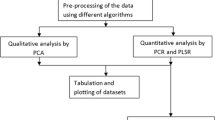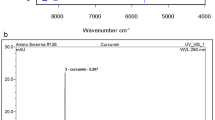Abstract
Nondestructive method of measuring curcuminoid content of turmeric powder was developed by fourier transform near infrared (FT-NIR) spectrometer. Also, the calibration models describing the relationship between curcuminoid content and the NIR spectra of the turmeric powder were developed and evaluated. To develop the model, NIR reflectance spectra were acquired for each turmeric powder sample. Spectra were pre-processed by applying different spectra correction algorithms. The relationship between spectrometric curcuminoid content and FT-NIR spectra of turmeric powder was examined through partial least square (PLS) regression method in the wave number range of 6102 to 4246 cm−1. The root mean square error of cross-validation and test set validation were 0.104 and 0.201 whereas the determination coefficient (R2) for both the validations were 97.64 and 87.53, respectively. A low value of root mean square error and high value of R2 indicates a high correlation between the concentration and spectral data. Thus the FT-NIR offers a viable alternative to spectroscopic procedures as well as the method is time and cost effective for determination of curcuminoid content of turmeric.
Similar content being viewed by others
Avoid common mistakes on your manuscript.
Introduction
Turmeric (Curcuma longa L.), a member of the Zingiberaceae family, is a traditional Indian curry spice. It is also used as a yellow food colourant and has been used in traditional medicines in India and ancient Egypt since last 6000 years. During the past 50 years, it has been subjected to numerous trials and studies and its use has been validated and clarified by modern science. It has been used for the treatment of various diseases and disorders particularly for urticaria, skin allergy, viral hepatitis, inflammatory conditions of joints, sore throat and for wounds (Chattopadhyay et al. 2004). The active ingredients responsible for its bright yellow-orange coloured pigment and medicinal properties are a group of phenolic compounds composed mainly of curcumin (C), demethoxy curcumin (DMC) and bisdemethoxy curcumin (BDMC) and have been shown to possess anti-oxidant, anti-inflammatory, anti-carcinogenic, anti-mutagenic, anti-fungal, anti-viral and acaricidal properties (Ahsan et al. 1999; Chattopadhyay et al. 2004; Gulati 2007). The curcuminoid in turmeric powder plays an important role in its biological properties. The active chemical constituents present in a plant material serve as a characteristic fingerprint for that plant and help to develop analytical techniques to ascertain the quantity of active constituents in botanically derived products. Most common methods reported for the determination of curcuminoid content are spectrophotometric, HPTLC and HPLC. But these methods are very cumbersome and time-consuming and also not economically viable (Khurana and Ho 1988; Taylor and Mc Dowell 1992; Schieffer 2002).
Fourier transform near-infrared (FT-NIR) spectroscopy is an analytical technique that has gained popularity in recent years for analyzing a wide variety of samples used in agricultural, nutritional, petrochemical, textile and pharmaceutical industries. The major strengths of FT-NIR include fast and easy equipment operation, high accuracy, precision and the potential to perform nondestructive analysis. Therefore it was thought worthwhile to develop a simple and non-destructive FT-NIR method for analysis of curcuminoid percentage occurring in roots of C. longa.
Material and methods
Sample preparation and analysis
Twenty-one dried rhizome samples of different turmeric genotypes (NVST-No.) and 21 samples of variety ‘Sugundhum’ and 3 samples of variety ‘Kesar’ were obtained from Department of Agriculture Botany of the college. These samples were powdered to reduce the size and sieved with 0.2 mm screen. The curcuminoid content in the calibration samples were analyzed by standard colorimetric ASTA method 18.0 (ASTA 1968). The samples were weighed accurately to about 0.01 g and transferred to a 125 ml Erlenmeyer flask. The samples were extracted with acetone by refluxing on hot plate with wet condenser for 1 h. Samples were filtered using Whatman No.1 filter paper in 200 ml volumetric flask and diluted with acetone. One ml of this solution was pipetted to 100 ml volumetric flask and diluted to volume with acetone. The curcuminoid content was calculated from the absorbance at 420 nm using a UV-VIS spectrophotometer (Systronics, India, Model 2201). The highest value of curcuminoid content was found in genotype ‘NVST 45’ (3.95%), whereas lowest value was found in genotypes ‘NVST 32’ and ‘NVST 39’ (1.79%).
FT-NIR Instrument
The FT-NIR spectrometer (Bruker Optics MPA, Germany) used for the study was capable of measurements in transmission mode in sample compartment and measurement in diffuse reflection mode using integrating sphere. The PbS detector (12,800 to 3600 cm−1) was used for analyzing the samples.
Spectra acquisition
The NIR spectra of calibration turmeric samples were collected in the reflectance mode using FT-NIR spectrometer with a rotating integrating sphere. The petri dishes (100 mm × 20 mm) filled with powdered turmeric sample were kept in the integrating sphere equipped with a rotating cup assembly to record accurate spectra of samples in the range of 12,800–3600 cm−1. For each calibration standard, the spectrum was attained by averaging three spectral scans. The room temperature was kept around 25°C and the humidity was at steady level of 58–60% in the laboratory.
Data analysis
Acquired spectra were analyzed by Quant 5.5 software. As the samples were containing several components in the matrix, thus the spectra will show considerable overlap bands. Therefore, multivariate calibration was used which correlates considerably more spectral information using larger spectral range with reference value of calibration set. This leads to a higher degree of precision with reduced chance error.
Partial least square (PLS) regression was used to correlate data in spectra matrix with the data in the concentration matrix for developing calibration model to determine the curcuminoid content. The samples (48) were divided in the two sets, viz., calibration sample and validation sample set randomly, each set containing 24 samples. The matrixes were reduced to only a few factors using all the available information to avoid over fitting of the model. The quality of the calibration model for prediction of curcuminoid content was checked by cross validation of the model.
Results and discussion
NIR spectrum
The spectrum of turmeric sample in wavenumber ranged between 12800 and 3600 cm−1 as shown in Fig. 1. For improving the chemo-metric model, it is necessary to focus the PLS regression on groups that contain significant information for the system. So an interactive frequency region was selected to improve the calibration model. The region above 6102 cm−1 did not contain any useful information. The peaks at 3614 cm−1 (AU = 1.82) and 4500 cm−1 (AU = 0.83) showed very strong absorption and were not included. In general, band between 0.7 and 1.0 absorbance unit (AU) generate the best results. In addition, we limited the wavenumber range to 4246 cm−1 because below this value there was not any spectral information. This spectral region was further divided into two interactive spectral regions of wavenumber 6102 to 5446 cm−1 and 4601 to 4246 cm−1 (Fig. 2). Different spectra algorithms like vector normalization, multiplicative scattering correction, min-max normalization, constant offset elimination, straight line subtraction, first derivative and second derivative were used for preprocessing of spectra for reproducibility of calibration model. The spectra of all samples were almost parallel (Fig. 2), which indicates linear response of the instrument along with sample concentrations within the range of study. Similar spectral responses (strong and weak absorbance characteristics of orange juice within the region of study) were obtained by Jha (2007) for determining the sweetness of orange juice in terms of total soluble solids by FT-NIR.
Calibration and cross-validation
The number of samples used in the calibration set, test set and statistical summary of laboratory determined curcuminoid content is given in Table 1. The PLS regressions were performed on spectra in the range of 6102 to 4246 cm−1. The regression method assumes that systemic variations observed in the spectra are a consequence of the concentration change of curcuminoid in the sample. The spectral matrix and data matrix are broken into their eigenvectors, which are called factors or principal components. The advantage of this approach is that not all of the principal components are necessary to describe. Only the relevant principal components will then be used instead of the original spectral data and then system is analyzed for each component spectra to identify the group of most effective wavelength for the prediction of curcuminoid content in the turmeric sample. The chemo-metric model developed was evaluated by cross validation to test its reliability of calculation of curcuminoid concentration. The root mean square error of cross validation (RMSECV) was found to be 0.104. The determination coefficient (R2) was found to be 97.64. The quality of calibration model was quantified by RMSECV and R2 value. The R2 gives the percentage of variance present in the true curcuminoid concentration, which is reproduced in the regression. The higher value of coefficient represents better correlation between the concentration data and spectral data. Figure 3 shows diagrammatic representation of the validation results. The straight line represents that the predicted values lie close to the true value. The calibration model developed was used to predict the curcuminoid content in 24 validation samples that had not been included in the calibration set and the prediction results are shown in Table 2. Determination coefficient (R2) indicated a strong relationship between predicted value and actual value of curcuminoid content. This technique has been standardized for the determination of various parameters including tetracycline in milk (Sivakesava and Irudayaraj 2002), identification of tea varieties (Chen et al. 2008), sweetness of orange juice (Jha 2007) and lignin content in Acacia. spp. (Yao et al. 2010).
Conclusion
The FT-NIR is user friendly, speedy, cost effective, non destructive and therefore offers a viable alternative to colorimetric procedures. The technique can be applied for turmeric varieties containing varying amounts of curcuminoid. The calibration model developed showed RMSECV of 0.104 and R2 value of 97.64, indicating that curcuminoid content can be predicted by NIR technique. The accuracy and precision of the results were comparable to the standard method. A reliable overall characterization of a food product quality may be obtained at a low cost. It may be applied to quality control, process monitoring and rapid classification in the industry.
References
Ahsan H, Parveen N, Khan NU, Hadi SM (1999) Pro-oxidant, antioxidant and cleavage activities on DNA of curcumin and its derivatives demethoxycurcumin and bis-demethoxycurcumin. Chem Biol Interact 121:161–175
ASTA (1968) Official analytical methods manual, 2nd edn. American Spice Trade Association, NewYork, p 38
Chattopadhyay I, Biswas K, Bandyopadhyay U, Banerjee RK (2004) Turmeric and curcumin: biological actions and medicinal applications. Curr Sci 87:44–50
Chen Q, Zhao J, Liu M, Cai J (2008) Nondestructive identification of tea (Camellia sinensis L.) varieties using FT-NIR spectroscopy and pattern recognition. Czech J Food Sci 26:360–367
Gulati R (2007) Turmeric (Curcuma longa L.) as acaricidal against Tyrophaguus putrescentiae Schank and Suidasia nesbitti Huhes in stored wheat. J Food Sci Technol 44:367–370
Jha SN (2007) Nondestructive determination of sweetness of orange juice using portable near infrared spectroscopy. J Agric Eng 44(3):10–14
Khurana A, Ho CT (1988) High performance liquid chromatographic analysis of curcuminoids and their photo-oxidative decomposition compounds in Curcuma longa L. J Liquid Chromatogr 11:2295–2304
Schieffer GW (2002) Pressurized liquid extraction of curcuminoids and curcuminoid degradation products from turmeric (Curcuma longa) with subsequent HPLC assays. J Liquid Chromatogr Related Technol 25:3033–3044
Sivakesava S, Irudayaraj J (2002) Rapid determination of tetracycline in milk by FT-MIR and FT-NIR spectroscopy. J Dairy Sci 85:487–493
Taylor SJ, Mc Dowell IJ (1992) Determination of the curcuminoid pigments in turmeric (Curcuma domestica Val.) by reversed phase high performance liquid chromatography. Chromatographia 34:73–77
Yao S, Wu G, Xing M, Zhou S, Pu J (2010) Determination of lignin content in Acacia spp. using near infrared spectroscopy. BioRes 5:556–561
Acknowledgement
Authors are thankful to the Botany Department of the college for providing the turmeric samples for this research work.
Author information
Authors and Affiliations
Corresponding author
Rights and permissions
About this article
Cite this article
Tripathi, S., Patel, K.G. & Bafna, A.M. Nondestructive determination of curcuminoids from turmeric powder using FT-NIR. J Food Sci Technol 47, 678–681 (2010). https://doi.org/10.1007/s13197-010-0094-1
Revised:
Accepted:
Published:
Issue Date:
DOI: https://doi.org/10.1007/s13197-010-0094-1







